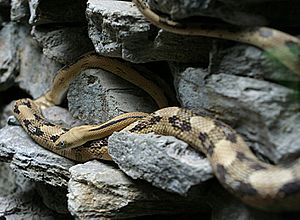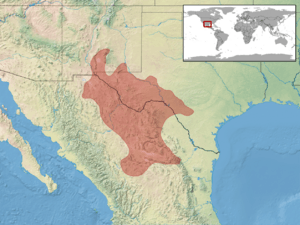Trans-Pecos rat snake facts for kids
Quick facts for kids Bogertophis subocularis |
|
|---|---|
 |
|
 |
|
| Trans-Pecos rat snakes at the Houston Zoo |
|
| Conservation status | |
| Scientific classification | |
| Genus: |
Bogertophis
|
| Species: |
subocularis
|
 |
|
| Synonyms | |
|
|
The Trans-Pecos rat snake, also known as the Davis Mountain rat snake, is a cool reptile! Its scientific name is Bogertophis subocularis. This snake is a medium to large-sized snake that is not venomous, meaning it's not dangerous to humans. It belongs to a group of snakes called Colubridae. You can only find this special snake in the Chihuahuan Desert.
Contents
Where Trans-Pecos Rat Snakes Live
The Trans-Pecos rat snake lives in parts of both Mexico and the United States.
Countries and States
In Mexico, you can find them in the states of Chihuahua, Coahuila, Durango, and Nuevo León. North of the border, they live in Texas and New Mexico in the United States.
What Trans-Pecos Rat Snakes Look Like
This snake has some unique features that help you identify it.
Snake Scales and Colors
One special thing about B. subocularis is that it has a row of small scales right below its eyes. These are called suboculars. Its body is usually yellow or tan, with cool black or dark brown H-shaped patterns along its back.
Its eyes are big and stand out, usually light-colored with a round, black pupil. The snake's tongue is pink. It has many scales on its back, usually 31 to 35 rows around the middle of its body. It also has many scales on its belly (260-277) and under its tail (69-79).
How Big Do They Get?
Adult Trans-Pecos rat snakes are typically about 36 to 54 inches (90–137 cm) long, including their tail. The longest one ever recorded was 66 inches (168 cm) long! That's taller than many kids!
Trans-Pecos Rat Snake Habitat
These snakes like to live in specific places in the desert.
Desert Homes
Their home is usually in flat desert areas and on brushy slopes. They also like rocky spots where they can hide or make their dens.
What Trans-Pecos Rat Snakes Eat
The Trans-Pecos rat snake is a carnivore, meaning it eats other animals.
Snake Diet
They mostly eat small vertebrates, which are animals with backbones. This could include small rodents, birds, or lizards.
Trans-Pecos Rat Snake Behavior
These snakes have some interesting habits.
Night Owls of the Desert
B. subocularis is a nocturnal animal, which means it is most active at night. Because of this, and because they are not very common, you rarely see them in the wild. You might spot one on a warm summer night, especially during their breeding season.
Snake fans sometimes call them "subocs." If you ever meet one, don't worry! They are usually not aggressive and are quite calm, even when approached. This makes them popular pets for people who know how to care for snakes.
Trans-Pecos Rat Snake Reproduction and Life Cycle
The life cycle of these snakes involves a long incubation period for their eggs.
Breeding and Hatching
Trans-Pecos rat snakes usually breed in May and June. The female snakes then lay their eggs between July and September. Their eggs take a long time to hatch, almost three months! This is quite a long time for a snake egg.
When they hatch, a mother snake can have anywhere from three to 11 baby snakes in one group, called a clutch. Each baby snake is about 28 to 33 cm (11–13 in) long when it hatches. Since they hatch during the colder winter months, the baby snakes might stay hidden underground for several months before they come out to explore the world.


